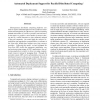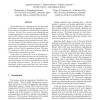IAT
2006
IEEE
14 years 6 months ago
2006
IEEE
The dynamic nature of many real-world domains (e.g., military, emergency first response and hurricane relief, etc) requires adaptive resource allocation to respond to changes in t...
CODES
2006
IEEE
14 years 6 months ago
2006
IEEE
Middleware for parallel and distributed systems is designed to virtualize computation and communication resources so that a more and consistent view of those resources is presente...
CCGRID
2006
IEEE
14 years 6 months ago
2006
IEEE
The grid deals with large scale and ever-expanding environment which contains million of users and resources. For this reason, resource selection has been a challenging task espec...
SEMWEB
2007
Springer
14 years 6 months ago
2007
Springer
Semantic relevance among information resources can play an effective role in information retrieval, and there are several different approaches to measure semantic similarities. H...
ECOWS
2007
Springer
14 years 6 months ago
2007
Springer
Service orientation is the de-facto architectural style, today. But, what actually is a service and how should service boundaries be chosen? Resource orientation, once seen as a �...
PDP
2007
IEEE
14 years 6 months ago
2007
IEEE
Heterogeneous distributed computing platforms continue to require substantial effort in terms of software installation and management for efficient use, often necessitating manua...
IPPS
2007
IEEE
14 years 6 months ago
2007
IEEE
Applications such as parallel computing, online games, and content distribution networks need to run on a set of resources with particular network connection characteristics to ge...
ICPADS
2007
IEEE
14 years 6 months ago
2007
IEEE
Grid technologies are emerging as the next generation of distributed computing, allowing the aggregation of resources that are geographically distributed across different location...
HPDC
2007
IEEE
14 years 6 months ago
2007
IEEE
Although WSRF (Web Services Resource Framework) and Java-based hosting environment have been successful in dealing with the heterogeneity of resources and the diversity of applica...
ESCIENCE
2007
IEEE
14 years 6 months ago
2007
IEEE
Grid economy provides a mechanism or incentive for resource owners to be part of the Grid, and encourages users to utilize resources optimally and effectively. Advance reservation...





